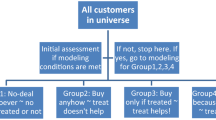Abstract
We propose a model for developing optimal decisions and normative policies for pricing and advertising of products/services to markets at the ‘bottom of pyramid (BOP).’ This concept has been popularized in the recent times by Prahalad (The fortune at the bottom of the pyramid, 2006). Our model considers two types of market segments. The first type is the BOP market, which is large in size, but has limited ability to pay. The second type of the market is smaller in size, but can pay higher prices. The product/service offered to the two markets is differentiated in such a way that the base product (of appropriate quality) is available to the BOP market, while the premium product at a higher price is available to the higher-end market. The two markets are linked to each other such that there is a positive effect of customer base in the BOP market on the diffusion of product in the Premium market. Successful practices of such kind of models have been reported in widely documented healthcare case studies such as Aravind Eye Care (Kasturi Rangan, Service for sight, 1993). The product diffusion in the two markets is modeled using a pure innovation model by Fourt and Woodlock (J Mark, 25:31–38, 1960). Using optimal control methodology, we derive pricing and advertising policies for two types of organizations—for-profit organization (FPO) and non-profit organization (NPO). Thus, our analytical research design follows a 2 × 2 × 2 × 2 (markets—BOP vs. Premium, strategies—pricing and advertising, organizations—FPO vs. NPO, and modeling—static vs. dynamic) design. Our optimal normative policy results can be summarized as follows: (i) A NPO charges lesser price per unit in both BOP and Premium markets, as compared to the FPO, (ii) A NPO spends equal amount of money in advertising or promoting the product/service as that spent by a FPO, (iii) A FPO charges lesser price per unit in the BOP markets as compared to the Premium market, (iv) The FPO receives lesser contribution margin per unit in the BOP market, as compared to the Premium market, (v) For the FPO, the ratio of advertising/promotion done in BOP market to that in the Premium market is governed by the parameters such as relative advertising effectiveness, cost of advertising, and contribution margin per unit in the two markets, (vi) Our dynamic pricing policy results for a FPO show that the prices are gradually increasing in the Premium market, and gradually decreasing in the BOP market, albeit after a threshold level of sales. The dynamic advertising policy results for a FPO show that advertising should gradually be decreased in the BOP market, but should remain stable in the Premium market. The NPO dynamic pricing and advertising results are similar to their static counterparts, though at much lower price levels.



Similar content being viewed by others
Notes
This conclusion was based on a study done originally by Monitor Consulting Group (2009).
Our major objective to present these optimal functional forms is to compare the similar expressions for the case of NPO’s. The case of closed-form exact solution will be taken up in a subsequent section.
In case of Weinberg (1983), donor subsidy was a function of demand generation.
We have analyzed our model with a specific upper-bound constraint on the prices in the BOP market. However, our results are not materially affected by this restriction. Therefore, we proceed with the parsimonious model of this section.
The x’ notation is meant to indicate derivative with respect to t. Thus, x’ = dx/dt.
The subscript t is dropped for better exposition from this point onwards.
Pure innovation model is the most parsimonious form at this initial level of specification of the model. This model can readily be extended to include imitation effects using Bass (1969) model, or its later variants to include other marketing variables.
Note that in the optimal control model, we consider the complete effect of “stock” of consumers in BOP market on the adoptions in the Premium market. Although this has been done primarily for the parsimony of the model concerned, it can be reasonably interpreted as the “influence” that the adopters in the BOP market would have on the diffusion in the Premium market.
References
Agarwal, Manoj, Guido Berens and Anand K. Jaiswal (2011), CSR and BOP marketing: Are they two sides of the same coin? Proceedings of 4th IIMA conference on marketing in emerging economies, Indian Institute of Management, Ahmedabad, 5–7 January 2011.
Augustine Grace 2008. Do companies that engage in BOP markets outperform the market? Stanford Center for Social Innovation, http://csi.gsb.stanford.edu/do-companies-engage-bop-markets-outperform-market. Accessed 11 June 2012.
Bass, and M. Frank. 1969. A new product growth model for consumer durables. Management Science 15: 215–227.
Bayus, BarryL. 1994. Optimal pricing and product development policies for new consumer durables. International Journal of Research in Marketing 11: 249–259.
Bennett, R., and R. Kottasz. 2000. Advertising style and the recruitment of charity volunteers. Journal of Nonprofit & Public Sector Marketing 8(2): 45–63.
Bennett, R., and A. Sargeant. 2005. The nonprofit marketing landscape: Guest editors’ introduction to a special section. Journal of Business Research 58: 797–805.
Buratto, A., L. Grosset, and B. Viscolani. 2006. Advertising a new product in a segmented market. European Journal of Operational Research 175: 1262–1275.
Caldwell, N. 2000. The emergence of museum brands. International Journal of Arts Management 2(3): 28–34.
Davidson, K. 2009. Ethical concerns at the bottom of the pyramid. Where CSR meets BOP. Journal of International Business Ethics 2(1): 22–32.
Goldberg, E. Marvin, Martin Fishbein, and Susan.E. Middlestadt. 1997. Social marketing: Theoretical and practical perspectives. Routledge: Taylor and Francis Press.
De Silva, Harsha, Ratnadiwakara, Dimuthu and Zainudeen, Ayesha 2009. Social Influence in mobile phone adoption: Evidence from the bottom of pyramid in emerging Asia, Available at SSRN: http://ssrn.com/abstract=1564091 or http://dx.doi.org/10.2139/ssrn.1564091 Accessed on 6 June 2012.
Feichtinger, G., R.F. Hartl, and S.P. Sethi. 1994. Dynamic optimal control models in advertising: recent developments. Management Science 40(2): 195–226.
Fisher, J.C., and R.H. Pry 1971. A simple substitution model of technological change, technological forecasting and social change, 3:75–88.
Fourt, L.A., and J.W. Woodlock 1960. Early prediction of market success for grocery products. Journal of Marketing 25: 31–38.
Garrette, Bernard, and Aneel Karnani. 2010. Challenges in marketing socially useful goods to the poor. California Management Review 52(4): 29–47.
Guesalaga, Rodrigo, and Pablo Marshall. 2008. Purchasing power at the bottom of the pyramid: Differences across geographic regions and income tiers. Journal of Consumer Marketing 25(7): 413–418.
Horsky, D., and K. Mate. 1988. Dynamic advertising strategies of competing durable goods producers. Marketing Science 7(4): 356–367.
Horsky, D., and L.S. Simon. 1983. Advertising and the diffusion of new products. Marketing Science 2: 1–18.
Kamien, M., and N. Schwartz. 1981. Dynamic optimization: The calculus of variations and optimal control theory in economics and management. Amsterdam: North-Holland.
Karnani, Aneel. 2006. Misfortune at the bottom of the pyramid. Greener Management International 51(51): 99–110.
Karnani, Aneel. 2008. Help, don’t romanticize, the poor. Business Strategy Review Summer, pp. 48–53.
Kotler, P., and G. Zaltman. 1971. Social marketing: An approach to planned social change. Journal of Marketing 44: 24–33.
Kotler, P. 1979. Strategies for introducing marketing into nonprofit organisations. Journal of Marketing 43: 7–44.
Kotler, P., and K.F.A. Fox. 1985. Strategic marketing for educational institutions. Englewood Cliffs: Prentice-Hall.
Kotler, P., and A. Andreasen. 1987. Strategic marketing for nonprofit organisations, 3rd ed. Englewood Cliffs: Prentice-Hall.
Landrum, N.E. 2007. Advancing the ‘base’ of the pyramid debate. Strategic Management Review 1(1): 1–12.
Liu, Yong., and Charles B. Weinberg. 2004. Are nonprofits unfair competitors for businesses? An analytical approach. Journal of Public Policy & Marketing 23(1): 65–79.
Lovelock, C.H., and C.B. Weinberg. 1990. Public and Nonprofit Marketing, 2nd ed. San Francisco: Scientific Press.
Mahajan, V., and E. Muller. 1986. Advertising pulsing policies for generating awareness for new products. Marketing Science 5(2): 86–106.
Mahajan, V., and R. Peterson. 1978. Innovation diffusion in a dynamic potential adopter population. Management Science 24: 1589–1597.
Mahajan, Vijay, Eitan Muller., and Frank M. Bass. 1990. New Product Diffusion Models in Marketing: A review and directions for research. Journal of Marketing 54: 1–26.
Mansfield, E. 1961. Technical change and the rate of inflation. Econometrica 9: 741–765.
Marinelli, Carlo. 2007. The stochastic goodwill problem. European Journal of Operational Research 176(1): 389–404.
Parker, P.M., and M. Sarvary. 1997. Formulating dynamic strategies using decision calculus. European Journal of Operational Research 98: 542–554.
Pitta, DennisA, Rodrigo Guesalaga., and Pablo Marshall. 2008. The quest for the fortune at the bottom of the pyramid: Potential and challenges. Journal of Consumer Marketing 25(7): 393–401.
Prahalad, C.K., and Hammond Allen. 2002. Serving the world’s poor, profitably. Harv Bus Rev 80(9): 48–57.
Prahalad, C.K. 2006. The fortune at the bottom of the pyramid. Philadelphia: Wharton School Publishing.
Prahalad, C.K. 2009. Introduction to the fortune at the bottom of the pyramid: revised and updated 5th anniversary edition, www.ftpress.com/articles/article.aspx?p=1398628. Accessed 4 June 2012.
Quelch, J.A., J.E. Austin., and N. Laidler-Kylander. 2004. Mining gold in not-for-profit brands. Harv Bus Rev 82(4): 24.
Ramani, S.V., and V. Mukherjee 2011. Can radical innovations serve the poor (BOP) and create reputational (CSR) value? Indian case studies, proceedings of the 9th the global network for the economics of learning, innovation, and competence building systems (globelics) international conference, 15–17 November 2011, Buenos Aires, Argentina.
Kasturi Rangan, V. 1993. Case: Aravind Eye Hospital, Madurai: In Service for Sight. India: Harvard Business School Publishing.
Kasturi Rangan, V., Michael Chu, and Djordjija Petkoski. 2011. Segmenting the base of the pyramid. Harv Bus Rev 89(6): 113–117.
Ritchie, R.J.B., S. Swami., and C.B. Weinberg. 1998. A brand new world for non-profits. International Journal of Nonprofit and Voluntary Sector Marketing 4: 26–42.
Robinson, B., and C. Lakhani. 1975. Dynamic price models for new product planning. Management Science 10: 1113–1122.
Sargeant, A. 1999a. Marketing management of nonprofit organisations. Oxford: Oxford Univ Press.
Sargeant, A. 1999b. Charity giving: Towards a model of donor behaviour. Journal of Marketing Management 15: 215–238.
Sargeant, A. 2001. Using donor lifetime value to inform fundraising strategy. Nonprofit Management Leadership 12(1): 25–38.
Savaskan, R.C., and L.N. van Wassenhove. 2006. Reverse channel design: The case of competing retailers. Management Science 52(1): 1–14.
Sethi, S.P., and G.L. Thompson. 2000. Optimal control theory: Applications to management science and economics. Kluwer: Norwell.
Simon, Hermann. 1982. ADPULS: An advertising model with wearout and pulsation. Journal of Marketing Research 19: 352–363.
Subrahmanyan, Saroja., and J. Tomas Gomez-Arias. 2008. Integrated approach to understanding consumer behavior at bottom of pyramid. Journal of Consumer Marketing 25(7): 402–412.
Swami, Sanjeev., and Janat Shah. 2012. Channel coordination in green supply chain management. Journal of the Operational Research Society Advance. doi:10.1057/jors.2012.44.
Swami, Sanjeev., and Pankaj Khairnar. 2006. Optimal normative policies for marketing of products with limited availability. Annals of Operations Research 143(1): 107–121.
Swami, Sanjeev., and Arindam Dutta. 2010. Advertising strategies for new product diffusion in emerging markets: propositions and analysis. European Journal of Operational Research 204: 648–661.
Teng, J., and R. Thompson. 1983. Oligopoly models for optimal advertising when production costs obey a learning curve. Management Science 29: 1087–1101.
Vachani, Sushil., and N. Craig Smith. 2008. Socially responsible distribution: distribution strategies for reaching the bottom of the pyramid. California Management Review 50(2): 52–84.
Weinberg, Charles. 1983. Marketing mix decisions for nonprofit organizations: An analytical approach. In Pubic & nonprofit marketing, ed. H.Lovelock Christopher, and Charles B. Weinberg. New York: Wiley.
Weinberg, C.B., and R. Ritchie. 1999. Cooperation, competition and social marketing. Social Marketing Quarterly 5(3): 117–126.
Wood, Van R., Dennis A. Pitta., and Frank J. Franzak. 2008. Successful marketing by multinational firms to the bottom of the pyramid: Connecting share of heart, global “umbrella brands”, and responsible marketing. Journal of Consumer Marketing 25(7): 419–429.
Acknowledgment
The first author acknowledges the support provided by Supply Chain Management Center (SCMC), IIM Bangalore during his stay as Visiting Faculty in the summer of 2012.
Author information
Authors and Affiliations
Corresponding author
Rights and permissions
About this article
Cite this article
Swami, S., Tirupati, D. Optimal Pricing and Advertising Policies for Bottom of Pyramid Markets: An Analytical Approach. Technol. Oper. Manag. 3, 32–49 (2012). https://doi.org/10.1007/s13727-013-0014-5
Received:
Accepted:
Published:
Issue Date:
DOI: https://doi.org/10.1007/s13727-013-0014-5




